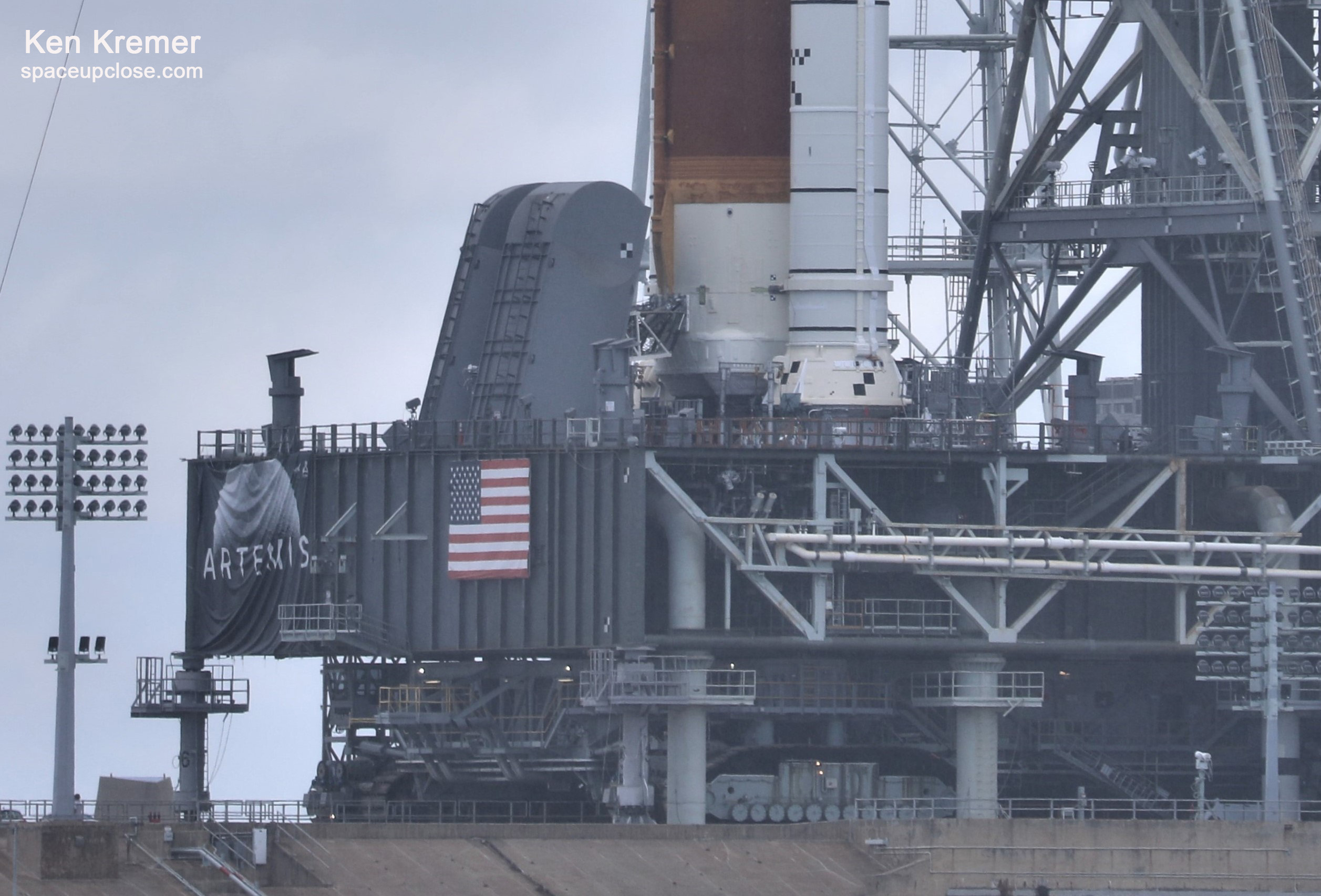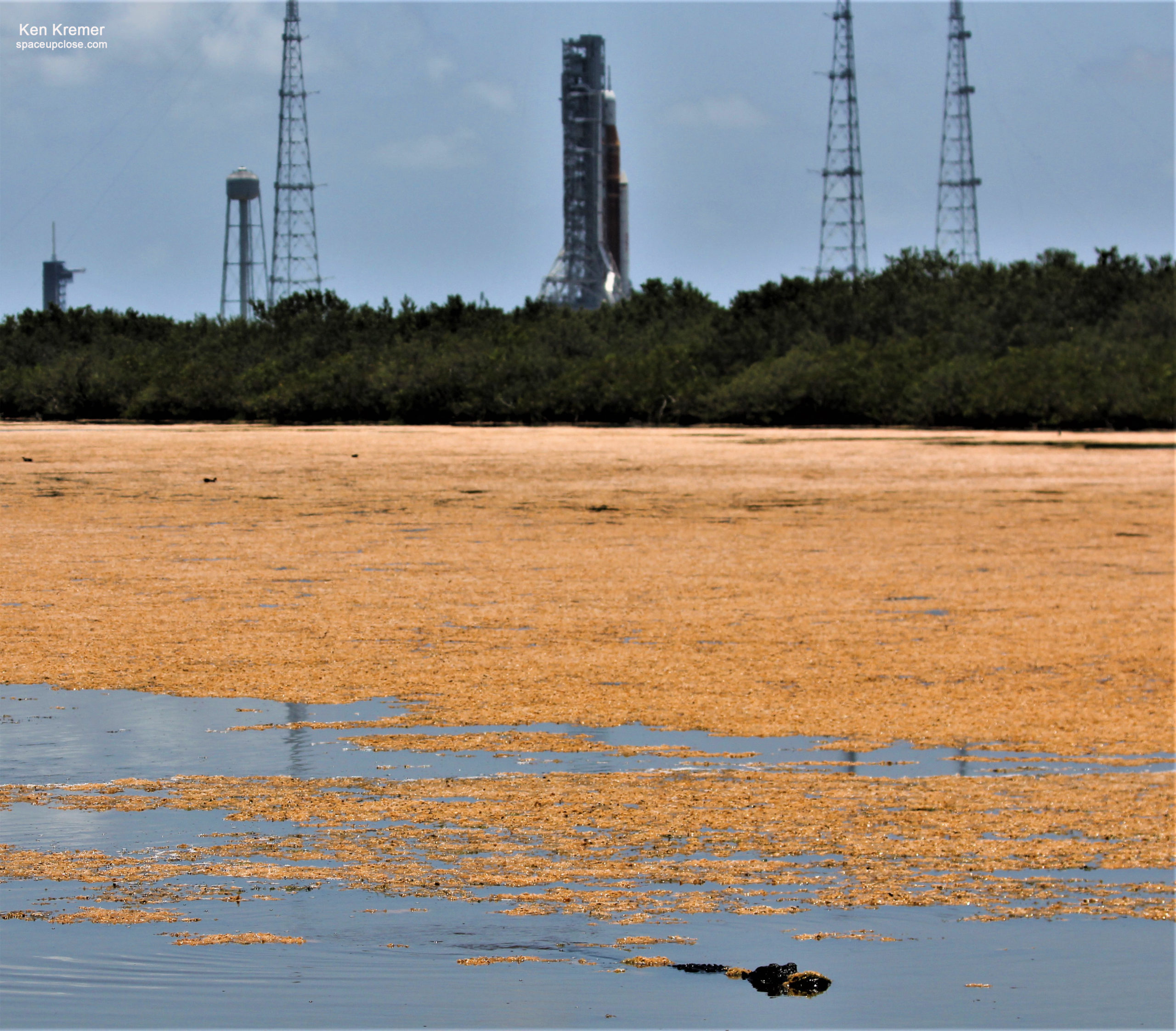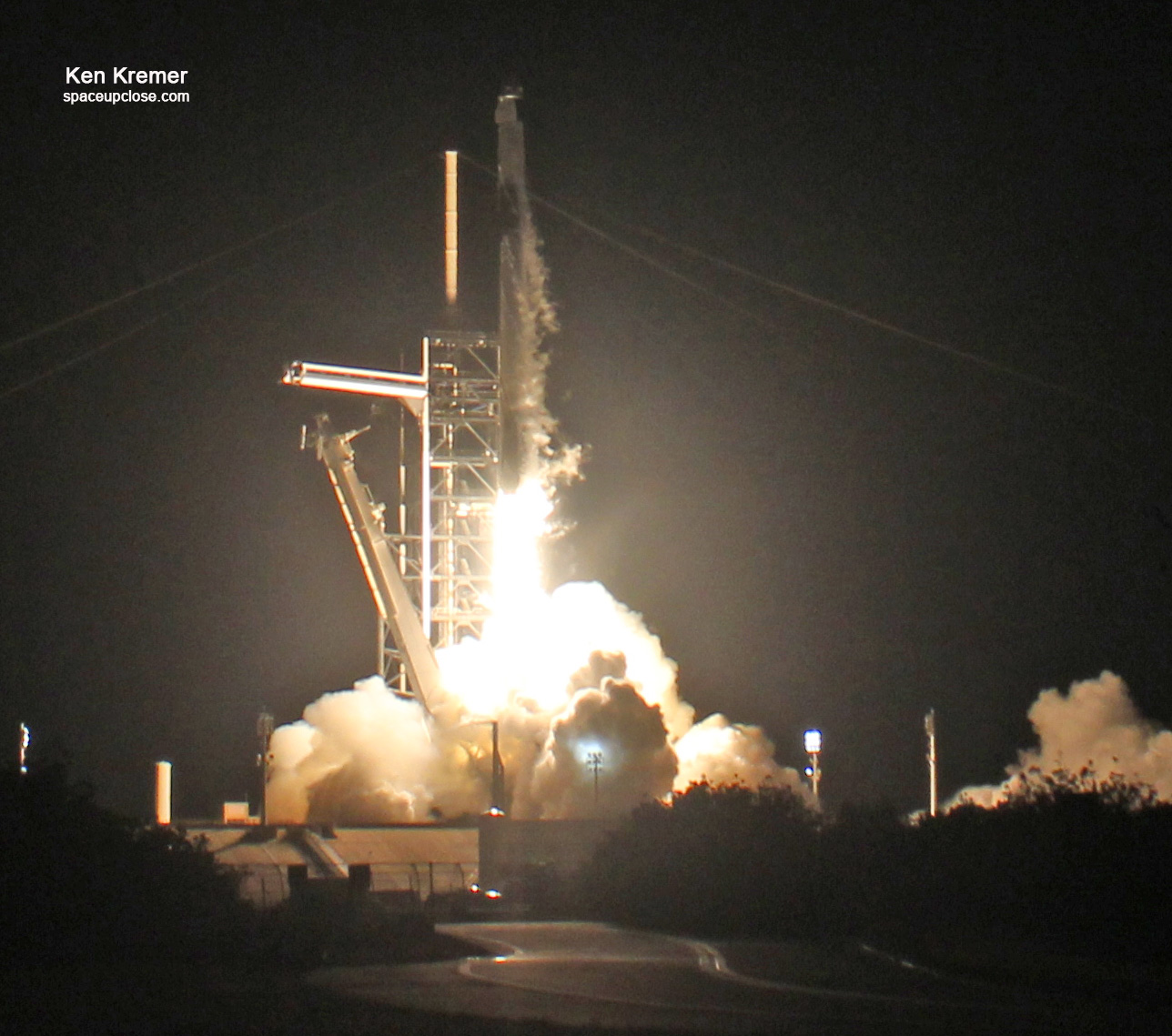
For SpaceUpClose.com & RocketSTEM
KENNEDY SPACE CENTER, FL – For the first time NASA was able to fully fuel both stages of the agency’s Mega Moon Rocket with supercold cryogenic propellants and enter the terminal countdown to within 29 seconds of T-Zero on Monday June 20, despite a hydrogen leak during the fourth attempt to complete the critical countdown and tanking test known as the Wet Dress Rehearsal (WDR) for the now repaired Space Launch System (SLS) Artemis 1 Moon rocket standing vertical at launch pad 39B at NASA’s Kennedy Space Center in Florida.
The Artemis 1 WDR test concluded at 7:37 p.m. EDT June 20 at T-29 seconds in the countdown ending a 2-day test campaign by fully loading liquid oxygen and liquid hydrogen into the SLS rocket core and upper stages, that began on Saturday, June 18, with a call to stations.
“Today’s test marked the first time the team fully loaded all the Space Launch System rocket’s propellant tanks and proceeded into the terminal launch countdown, when many critical activities occur in rapid succession,” NASA said June 20.
Thus the SLS launch team at KSC completed nearly all the primary and secondary objectives required for a successful WDR that would pave the way for NASA officials to decide to push ahead with preparations for the uncrewed Artemis 1 mission around the Moon later this summer, the team said at a post test briefing June 21.
They were also able to demonstrate replenish of propellants of both stages
Its not clear if another WDR test will be required to complete the remaining test objectives.
“This was definitely a good day for us and a very exciting day as well,” said Charlie Blackwell-Thompson, NASA’s Artemis launch director, during an interview Monday evening on NASA TV.
“Today, we got all stages to replenish,” Blackwell-Thompson said. “That was a big milestone for us, getting both the core stage and upper stage into replenish, and our team really wanted to get into terminal count and work through those milestones and see how we performed, how the team performed, and how the hardware performed, and they both performed very well.”
The NASA team will now thoroughly review all the data before deciding to proceed with the actual launch of the SLS/Orion crew module stack on the unpiloted Artemis 1 test flight mission to the Moon and back – now slated for NET no earlier than late August.
“Like any test we run, we’ll go take the data, we’ll go look at what we got we got and look at the couple of things that we didn’t get, and we’ll lay out a plan for how we go forward,” Blackwell-Thompson said.
The test did not proceed without a few difficulties that could have derailed the test from entering the terminal countdown phase – most notably a hydrogen leak in a quick disconnect that attaches to the tail service mast and is different from the earlier hydrogen leak inside plates in the tail service mast umbilical (TSMU).

The technical issues with hydrogen did prevent the team from achieving the goal of doing two terminal countdown runs with a final run to T Minus 9.3 seconds including a recycle in between
The team also had problems with loading liquid oxygen (LOX) into the ICPS upper stage when hitting a pressure limit but were able to develop work around modifications to complete the loading

Another problem encountered causing a delay was with the backup gaseous nitrogen system – unrelated to the GN2 upgrades from the prior WDR testing in April.
“During propellant loading operations earlier in the day, launch controllers encountered a hydrogen leak in the quick disconnect that attaches an umbilical from the tail service mast on the mobile launcher to the rocket’s core stage. The team attempted to fix the leak by warming the quick disconnect and then chilling it back down to realign a seal, but their efforts did not fix the issue,” said NASA officials.
“Launch controllers then developed a plan to mask data associated with the leak that would trigger a hold by the ground launch sequencer, or launch computer, in a real launch day scenario, to allow them to get as far into the countdown as possible.”
“The time required to develop the plan required extended hold time during the countdown activities, but they were able to resume with the final 10 minutes of the countdown, called terminal count.”
“During the terminal count, the teams performed several critical operations that must be accomplished for launch including switching control from the ground launch sequencer to the automated launch sequencer controlled by the rocket’s flight software, and important step that the team wanted to accomplish.”

During the WDR rehearsal the Artemis I launch team ran through operations to load propellant into the rocket’s tanks, conduct a full launch countdown, and also drain the tanks to give them an opportunity to practice the timelines and procedures they will use for launch.
The WDR rehearsal is the final test needed before Artemis 1 can launch and calls for NASA to load over 750,000 gallons of cryogenic liquid oxygen (LOX) and liquid hydrogen (LH2) propellants into the rocket’s core stage and second stage tanks,
They were not able to demonstrate the ability to recycle the countdown clock due to the hydrogen leak

The rocket was then rolled back to the VAB to carry out the repairs
“While inside the Vehicle Assembly Building (VAB), teams completed several major objectives, including assessing the liquid hydrogen system leak at the tail service mast umbilical, replacing the interim cryogenic propulsion stage (ICPS) gaseous helium system check valve and support hardware, and modifying the ICPS umbilical purge boots. The addition of hazardous gas detectors above the upper stage allows.”
The Space UpClose team of Ken Kremer and Jean Wright attended and witnessed the SLS/Orion 1st and 2nd rollouts from KSC Press Site and also witnessed the rollback return on April 26 to make the required repairs.
Enjoy our photos of SLS/Orion rolling out and back between the VAB and pad 39B.

Read my earlier detailed stories about the rollout, rollback and repairs illustrated with our photos
NASA will set a launch date for Artemis 1 only after successfully completing the WDR

After this WDR attempt the SLS/Orion stack will again be rolled back to the VAB for refurbishments, installation of the FTS and any further repairs and other work needed to ready for the launch campaign
Liftoff is expected NET late August

Watch Ken’s commentary about NASA SLS WDR demo test, SpaceX missions including Nilesat 301, Transporter-5, Boeing Starliner, NASA SpaceX Crew-3, Crew 4 and SpaceX AX-1 missions and Starlink and NASA TROPICS 1.
Jun 21/22: WFTV ABC Orlando News featured my commentary about NASA’s 4th SLS WDR fueling attempt Jun 20, the results and whats ahead after NASA conducts detailed analysis of the 1st tanking test to completely load both stages with LOX & LH2 and run the terminal count to T-29 sec despite a hydrogen leak – achieving many but not all objectives

Jun 17: Fox 35 Orlando featured my commentary about the selection of 2 NASA astronauts to fly on the 1st crewed mission of Boeing Starliner capsule on CFT test flight late 2022 – and what it means for human spaceflight to have a 2nd US commercial crew provider following the successful Boeing Starliner OFT-2 mission for NASA
Jun 9/10: WFTV ABC Orlando features my commentary about the upcoming NASA TROPICS 1 & 2 cubesat science launch on an Astra Rocket 3.3 from pad 46 for NASA which will study the formation and evolution of Tropical Cyclones and Hurricanes. Two more launches will follow for 6 TROPICS cubesats altogether over next few months
Jun 8: WFTV ABC Orlando features my commentary about the SpaceX Falcon 9 launch of NileSat301 telecom sat for Egypt
June 6/7: WFTV ABC Orlando features my commentary about completing 2nd rollout to pad 39B for 2nd round WDR tanking test, what’s involved in and why its critical to the future of Project Artemis:
May 25/26: WFTV ABC Orlando featured my commentary about the successful ISS undocking and touchdown of Starliner on OFT-2 test flight
May 19/20: WFTV ABC Orlando and Fox 35 Orlando featured my prelaunch and post launch commentary about the critical nature of the Boeing Starliner OFT-2 mission for NASA
May 11: WFTV ABC Orlando News featured my commentary & analysis about Boeing Starliner crew capsule targeting launch May 19 for long delayed OFT2 uncrewed test flight for NASA after completing FRR this afternoon. It must dock at ISS to be considered successful to enable follow-on NASA astronaut flights maybe by late 2022
Apr 29: WKMG CBS 6 with my commentary about the record setting Falcon 9 turnaround of 21 days since the Axiom-1 launch
Apr 22: Fox 35 Orlando features my analysis of the busy week ahead in space with weather delayed Earth return of AX-1 crew this weekend, launch of 4 NASA/ESA Crew-4 astronauts on SpaceX Crew Dragon NET Apr 26 & rollback of NASA SLS to VAB for repairs
https://www.fox35orlando.com/video/1060937
Apr 20: WFTV ABC News Orlando features my commentary about the SpaceX static fire and impact of weather induced delays to departure of Ax-1 and launch of Crew-4.
Apr 15/16 & Apr 12/13: WFTV ABC News Orlando and WKMG CBS 6 Orlando featured my comments about NASA SLS WDR wet dress rehearsal countdown and fueling demo test and human launches to ISS:
Apr 6: WFTV ABC 9 Orlando featured my comments about 1st fully private astronaut launch to ISS by SpaceX on AX-1 mission:https://www.wftv.com/news/local/brevard-county/first-all-private-astronaut-mission-iss-set-liftoff-kennedy-space-center-this-week/FYE5QAT735BA7G42O6IVCJGB4Q/
Apr 4 & 5: WFTV ABC News Orlando and Fox 35 Orlando featured my comments about NASA SLS WDR wet dress rehearsal countdown and fueling demo test and human launches to ISS
https://www.fox35orlando.com/news/nasa-resumes-artemis-i-wet-dress-rehearsal-countdown
Watch Ken’s continuing reports about Artemis, SLS, Orion and NASA missions, SpaceX Crew and Cargo Dragons, SpaceX Axiom-1, JWST, IXPE, DART, Lucy Asteroid mission, GOES, SpaceX Starlink, Commercial Crew and Starliner and Crew Dragon, Blue Origin and Space Tourism, and onsite for live reporting of upcoming and recent SpaceX and ULA launches including Crew 1 & 2 & 3 & 4, ISS, Solar Orbiter, Mars 2020 Perseverance and Curiosity rovers, NRO spysats and national security missions and more at the Kennedy Space Center and Cape Canaveral Space Force Station.
Stay tuned here for Ken’s continuing Earth and Planetary science and human spaceflight news: www.kenkremer.com –www.spaceupclose.com – twitter @ken_kremer – email: ken at kenkremer.com
Dr. Kremer is a research scientist and journalist based in the KSC area, active in outreach and interviewed regularly on TV and radio about space topics.
………….
Ken’s photos are for sale and he is available for lectures and outreach events
Please consider supporting Ken’s work by purchasing his photos and/or donating at Patreon
https://www.patreon.com/kenkremer


x



